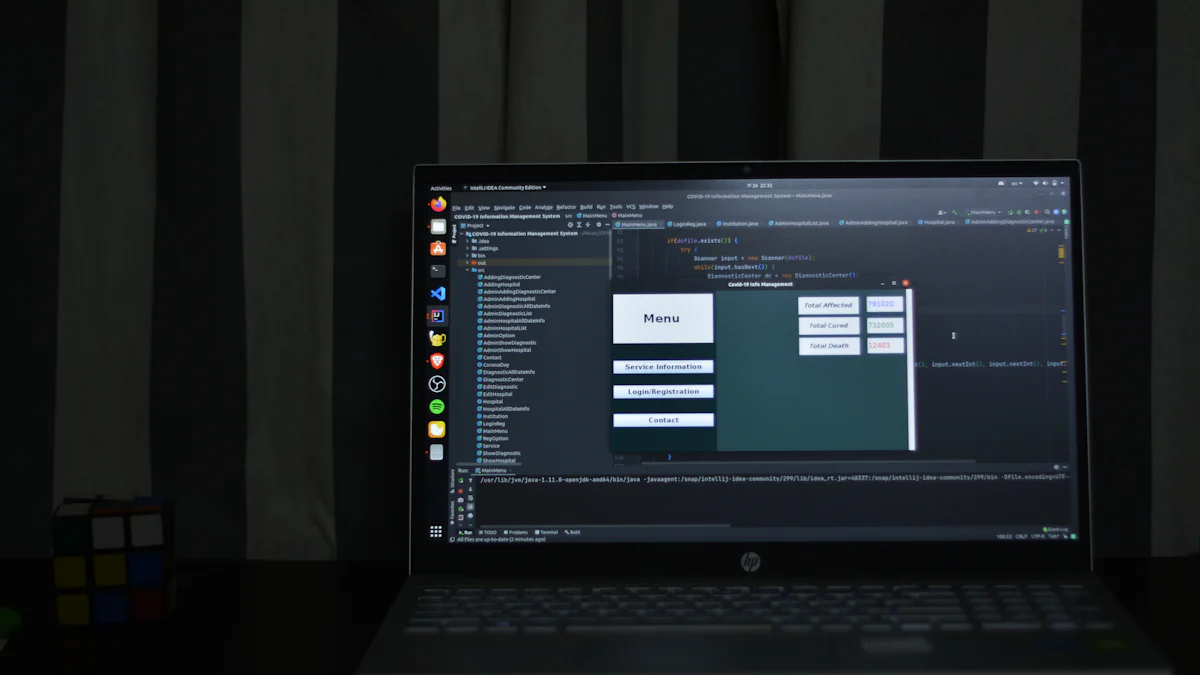Applicant Tracking System: The Right Tool to Track KPI

An Applicant Tracking System (ATS) revolutionizes how you track Key Performance Indicators (KPIs) in recruitment. By automating data collection and analysis, ATS enhances your hiring process efficiency. 94% of recruiters report positive impacts from using ATS, while companies see a 30% reduction in time-to-fill positions. Tracking KPIs is crucial for recruitment success. It helps you identify bottlenecks and optimize strategies. ATS offers benefits like improved data management, faster hiring, and better candidate experiences. Embrace ATS to streamline your recruitment and achieve strategic success.
Understanding Recruitment KPIs
Recruitment Key Performance Indicators (KPIs) serve as essential metrics for evaluating the effectiveness of your hiring process. These indicators provide insights into various aspects of recruitment, helping you make informed decisions and optimize strategies.
Definition of Recruitment KPIs
Recruitment KPIs are specific metrics that measure the success and efficiency of your hiring efforts. They include:
Time-to-Fill: The duration it takes to fill a vacant position.
Cost-per-Hire: The total cost involved in hiring a new employee.
Quality-of-Hire: The value a new hire brings to the organization.
Applicant Satisfaction: How candidates perceive their application experience.
Offer Acceptance Rate: The percentage of job offers accepted by candidates.
These KPIs help you assess efficiency, cost-effectiveness, and candidate suitability.
Significance of Tracking Recruitment KPIs
Tracking recruitment KPIs is crucial for enhancing your hiring process. By monitoring these metrics, you can identify areas for improvement and make data-driven decisions.
Impact on Recruitment Efficiency
Recruitment KPIs streamline your hiring process. By analyzing metrics like time-to-hire and applicant success rate, you can pinpoint bottlenecks and accelerate the recruitment cycle. This efficiency ensures that your team focuses on strategic tasks rather than manual data collection.
Influence on Hiring Quality
Monitoring KPIs like quality-of-hire allows you to evaluate the effectiveness of your recruitment strategies. You gain insights into how well new hires perform and contribute to your organization. This information helps you refine your hiring criteria and improve candidate selection.
An Applicant Tracking System (ATS) plays a vital role in tracking these KPIs. It automates data collection and analysis, providing you with real-time insights into your recruitment performance. By leveraging an ATS, you can enhance both efficiency and quality in your hiring process.
How Applicant Tracking System Aids in Tracking KPIs

An Applicant Tracking System (ATS) serves as a powerful tool for tracking Key Performance Indicators (KPIs) in recruitment. It offers features that streamline data collection and analysis, making it easier for you to monitor and optimize your hiring process.
Key Features of ATS for KPI Tracking
Data Collection and Analysis
An ATS automates the collection of recruitment data, reducing manual effort and minimizing errors. It records essential metrics like the number of applicants, time to hire, and sources of hire. This automation allows you to focus on strategic decision-making rather than data entry. By analyzing this data, you can identify trends and areas for improvement, ensuring a more efficient recruitment process.
Reporting and Visualization Tools
Robust reporting and visualization tools are integral to an ATS. These tools provide you with interactive dashboards and detailed reports, offering insights into your recruitment performance. You can easily track KPIs and visualize data trends, helping you make informed decisions. For instance, some ATS platforms integrate with tools like Microsoft Power BI, enabling real-time data visualization and enhancing your ability to monitor recruitment metrics effectively.
Examples of KPIs Tracked by ATS
Time to Hire
Time to hire is a critical KPI that measures the duration it takes to fill a vacant position. An ATS helps you track this metric by automating the recruitment process, from resume screening to interview scheduling. By reducing the time spent on administrative tasks, you can accelerate the hiring process and fill positions more quickly.
Cost per Hire
Cost per hire is another essential KPI that evaluates the total expenses involved in recruiting a new employee. An ATS provides detailed reports on recruitment costs, allowing you to analyze spending and identify cost-saving opportunities. By understanding where your resources are being allocated, you can optimize your budget and improve the overall cost-effectiveness of your recruitment efforts.
Incorporating an Applicant Tracking System into your recruitment strategy enhances your ability to track and analyze KPIs. With its advanced features, you can gain valuable insights into your hiring process, leading to improved efficiency and better hiring outcomes.
Setting Up MokaHR for KPI Tracking
To effectively track Key Performance Indicators (KPIs) in recruitment, setting up MokaHR as your Applicant Tracking System (ATS) is a strategic move. This section will guide you through selecting the right ATS and integrating data sources to ensure seamless KPI tracking.
Selecting the Right ATS
Choosing the right ATS is crucial for successful KPI tracking. You need to evaluate features and capabilities that align with your recruitment goals.
Evaluating Features and Capabilities
When selecting an ATS, consider its features and capabilities. Look for systems that offer robust data collection and reporting tools. These features will help you track essential KPIs like time-to-fill and cost-per-hire. Ensure the ATS provides user-friendly interfaces and customizable dashboards. This will allow you to tailor the system to your specific needs and enhance your recruitment process.
Considering Integration with Existing Systems
Integration with existing systems is vital for a smooth transition. Check if the ATS can seamlessly integrate with your current HR systems. This integration will enable you to synchronize data across platforms, ensuring consistency and accuracy. A well-integrated ATS will streamline your recruitment process and provide a comprehensive view of your hiring performance.
Integrating Data Sources
Integrating data sources is essential for accurate KPI tracking. You need to ensure that all relevant data is synchronized and consistent.
Synchronizing with HR Systems
Synchronizing your ATS with HR systems is a key step. This synchronization allows you to pull data from various sources, providing a holistic view of your recruitment metrics. By having all data in one place, you can easily track KPIs and make informed decisions. This integration also reduces manual data entry, saving time and minimizing errors.
Ensuring Data Accuracy and Consistency
Data accuracy and consistency are critical for reliable KPI tracking. Implement checks to ensure that data is accurate and up-to-date. Regular audits and validations can help maintain data integrity. Accurate data will enable you to make data-driven decisions and optimize your recruitment strategies effectively.
By setting up MokaHR as your Applicant Tracking System, you can enhance your ability to track and analyze recruitment KPIs. This setup will lead to improved efficiency and better hiring outcomes, ultimately boosting your company's recruitment success.
Optimizing MokaHR for KPI Tracking
Optimizing your Applicant Tracking System (ATS) like MokaHR for KPI tracking involves automating processes and continuously monitoring performance. This optimization ensures that you can efficiently track and analyze recruitment metrics, leading to improved hiring outcomes.
Automating Processes
Automation plays a crucial role in enhancing the efficiency of KPI tracking. By automating various recruitment tasks, you can save time and reduce errors.
Workflow Automation
Workflow automation streamlines your recruitment process. It allows you to automate repetitive tasks such as resume screening and interview scheduling. This automation reduces manual effort and speeds up the hiring process. You can focus on strategic decision-making while the system handles routine tasks. As a result, you achieve faster time-to-hire and improved candidate experiences.
Automated Reporting
Automated reporting provides you with real-time insights into your recruitment performance. The ATS generates detailed reports on key metrics like time-to-fill and cost-per-hire. These reports help you identify trends and areas for improvement. With automated reporting, you can make data-driven decisions without spending hours on manual data collection. This efficiency enhances your ability to optimize recruitment strategies.
Continuous Monitoring and Improvement
Continuous monitoring and improvement are essential for effective KPI tracking. By regularly reviewing KPIs, you can ensure that your recruitment process remains efficient and aligned with your goals.
Regular KPI Review
Regularly reviewing KPIs helps you stay informed about your recruitment performance. You can track metrics such as quality-of-hire and applicant satisfaction. This review process allows you to identify any deviations from your targets and take corrective actions. By staying proactive, you can maintain a high level of recruitment efficiency and quality.
Adjusting Strategies Based on Data Insights
Data insights from your ATS provide valuable information for adjusting recruitment strategies. You can analyze trends and patterns in your recruitment data to identify areas for improvement. For example, if you notice a high cost-per-hire, you can explore cost-saving measures. By leveraging data insights, you can refine your strategies and achieve better hiring outcomes.
Optimizing MokaHR for KPI tracking involves automating processes and continuously monitoring performance. By implementing these strategies, you can enhance your recruitment efficiency and make informed decisions that lead to successful hiring outcomes.
Benefits of Using Applicant Tracking System for KPI Tracking

An Applicant Tracking System (ATS) offers numerous advantages when it comes to tracking Key Performance Indicators (KPIs) in recruitment. By leveraging its capabilities, you can significantly enhance your recruitment processes and outcomes.
Enhanced Recruitment Efficiency
An ATS streamlines your recruitment workflow, making it more efficient. It automates time-consuming tasks such as job postings, resume screening, and interview scheduling. This automation reduces the time-to-fill positions by up to 30%, allowing you to recruit faster and more effectively. With an ATS, you can focus on strategic decision-making rather than getting bogged down by administrative duties. The system also improves collaboration among your hiring team, ensuring everyone stays on the same page and works towards common goals.
Improved Decision-Making
With an ATS, you gain access to comprehensive data and insights that inform your recruitment strategies. The system collects and analyzes data on various KPIs, providing you with a clear picture of your hiring performance. You can easily track metrics such as quality-of-hire and applicant satisfaction, enabling you to make informed decisions. By understanding trends and patterns in your recruitment data, you can refine your strategies and improve hiring outcomes. This data-driven approach leads to better hires and enhances the overall quality of your recruitment process.
Better Resource Allocation
An ATS helps you allocate resources more effectively. By providing detailed reports on recruitment costs, the system allows you to analyze spending and identify cost-saving opportunities. You can optimize your budget by understanding where your resources are being allocated. This optimization not only reduces the cost-per-hire but also ensures that you invest in the most effective recruitment channels. As a result, you achieve better resource allocation and improve the overall cost-effectiveness of your recruitment efforts.
Incorporating an Applicant Tracking System into your recruitment strategy offers significant benefits. It enhances recruitment efficiency, improves decision-making, and ensures better resource allocation. By leveraging these advantages, you can achieve successful hiring outcomes and drive your organization's growth.
Tips for Continuous Improvement
To ensure your recruitment process remains effective, continuous improvement is essential. Here are some tips to help you enhance your Applicant Tracking System (ATS) and overall recruitment strategy.
Staying Updated with ATS Features
Keeping your ATS updated with the latest features is crucial. New updates often include enhancements that can improve your recruitment efficiency. Regularly check for software updates and new functionalities. These updates can introduce advanced data analytics tools or improved user interfaces. By staying informed, you can leverage these features to optimize your recruitment process.
Training and Development for HR Teams
Your HR team plays a vital role in utilizing the ATS effectively. Providing regular training and development opportunities ensures they are well-equipped to use the system. Training sessions can cover new features, best practices, and troubleshooting techniques. This knowledge empowers your team to make the most of the ATS, leading to better recruitment outcomes. Encourage your team to share insights and experiences, fostering a collaborative learning environment.
Leveraging Feedback for System Enhancements
Feedback from users is invaluable for improving your ATS. Encourage your HR team and hiring managers to provide feedback on the system's performance. This feedback can highlight areas for improvement and guide future enhancements. For example, if users find certain features cumbersome, you can work with your ATS provider to address these issues. By actively seeking and implementing feedback, you ensure the system evolves to meet your organization's needs.
HR professionals emphasize the importance of using an ATS that captures all candidate details and interviewer notes. This approach streamlines data capture and centralizes information, helping hiring managers evaluate applicants efficiently.
By following these tips, you can continuously improve your recruitment process. Staying updated with ATS features, investing in training, and leveraging feedback will enhance your system's effectiveness. This commitment to improvement will lead to more successful hiring outcomes and support your organization's growth.
Utilizing an Applicant Tracking System (ATS) for tracking Key Performance Indicators (KPIs) offers numerous benefits. You can enhance recruitment efficiency, improve decision-making, and allocate resources more effectively. For instance, companies like Unilever have successfully reduced hiring time by 50% through ATS and KPI integration. Continuous improvement remains crucial. Regularly update your ATS features and train your HR team to maximize its potential. By leveraging these tools strategically, you can achieve successful recruitment outcomes and drive organizational growth. Embrace the power of ATS to transform your hiring process and stay competitive in today's talent market.
See Also
Unlocking The Secrets Of ATS For Career Advancement
Boosting Recruitment Clarity With Applicant Tracking Systems
Top 10 Essential Features Of ATS For Recruiters
From recruiting candidates to onboarding new team members, MokaHR gives your company everything you need to be great at hiring.
Subscribe for more information

